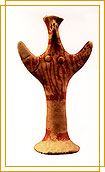Archeological evidence
Archeological
evidence suggests that the site of Olympia was already inhabited
in the Bronze Age.  The first inhabitants of the area built a large
tumulus, surrounded by a circular enclosure (peribolos)
made of large river stones. Up until recently, it was believed to
be a monument of Mycenean origins dedicated to the Mycenean hero
Pelops, but nowadays archeologists believe that it dates from the
third millenium BC. We do not know where its builders dwelt or why
they abandoned the site. Later on (ca.2000 BC), people lived in
apsidal houses, situated in the northern part of the city. It seems
that these houses did not follow a regular village plan, and they
contained burial jars and other pottery finds. The first inhabitants of the area built a large
tumulus, surrounded by a circular enclosure (peribolos)
made of large river stones. Up until recently, it was believed to
be a monument of Mycenean origins dedicated to the Mycenean hero
Pelops, but nowadays archeologists believe that it dates from the
third millenium BC. We do not know where its builders dwelt or why
they abandoned the site. Later on (ca.2000 BC), people lived in
apsidal houses, situated in the northern part of the city. It seems
that these houses did not follow a regular village plan, and they
contained burial jars and other pottery finds.
By ca.1600 BC, the Myceneans inhabited the area, as shown by the Mycenean graves found in the vicinity of the museum of Olympia. We do not know if there existed an altar dedicated to Pelops, or if ritual traditions existed for the site of Olympia in these early periods. Claimed ancestry of the games by a deified hero was a recurrent phenomenon in the Geometric Period, since hero cult became one of the customary means of defining local community identity.
We can only be sure that Olympia became a religious center during the Late Mycenean period. By this time and on, many people visited the site, dedicating a number of clay and bronze figurines to its deities. The excavators found these votive offerings in extensive black deposit of ash, dated to the 12th-8th centuries BC. Among the finds were Late Mycenean vases, animal figurines (bulls and horses), two-horse chariots and charioteers, warriors with spear, shield and helmet and tripod cauldrons, a find typically offered as a prize for winners. These objects were dumped in a layer levelled off during the cleansing and reorganization of the site in the early 8th century BC. It is not clear if these offerings are related solely to the cult of Zeus. Many of these offerings cannot be attributed to particular deities. Judging from the above, it seems probable that the cult of Zeus was introduced to Olympia some time after the 12th century BC.
|
